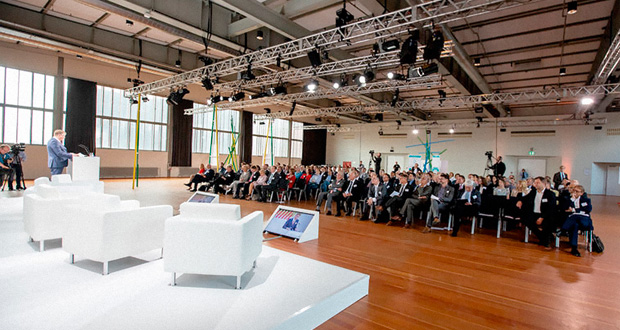With the project “Glückauf neighbours – model mining district integration”, which originated as part of the “Glückauf Zukunft!” initiative, the RAG-Stiftung, Essen/Germany, RAG Montan Immobilien, Essen/Germany, and VIVAWEST, Gelsenkirchen/Germany, are providing inspiration for successful integration in mining districts. The term “integration” is widely used in the project and refers not only to migration, but also to the participation of all sectors of society, regardless of origin, age, religion, or social status. In the form of a toolbox, the project delivers 26 solution approaches and 52 implementation ideas, which reinforce diversity, togetherness and quality of life in the region in equal measure, and are not only used in many districts in the Ruhr-gebiet, but also in other towns and urban areas. The toolbox was presented on 20th June 2018 during a symposium at the Zoll-verein UNESCO World Heritage Site in Essen.
“After the discontinuation of active mining, the Ruhrgebiet must remain and continue to develop as an attractive and appealing region for people to live,” stated Bernd Tönjes, Chairman of the Executive Board of the RAG-Stiftung, in his opening speech at the symposium (Figure 1). As an industrial urban area, the Ruhrgebiet is facing great challenges that it will need to overcome in future. In addition to changes in the economic situation, social developments such as demographic changes, increasing social contrasts and the integration of people of different ages, religions and cultures also generate a huge pressure for action. “With the “Glückauf neighbours” project, we want to prove our responsibility and desire for change and make a positive contribution to the subject of integration, particularly against the backdrop of the upcoming Ruhr conferences,” Tönjes continued.
“In 2018, the final coal mines in Bottrop and Ibbenbüren will close. This marks the end of a major chapter in the history of Germany and North-Rhine Westphalia. However, as one chapter ends, another begins, and brings opportunities for something new. This is the purpose behind the “Glückauf Zukunft!” initiative, and specifically the project “Glückauf neighbours – model mining district integration”. In this context, the symposium engages with issues surrounding the co-habitation of people, neighbourhoods, and thus with the core meaning of home. Home becomes tangible within neighbourhoods and day-to-day life. This is not an exclusive model – on the contrary, it is inclusive. This symposium is an important milestone towards continuing this inclusivity and securing sustainable development of our mining districts. “With this project, the RAG-Stiftung, RAG Montan Immobilien and VIVAWEST are breaking new ground in their industry and demonstrating a commitment to integration in the district,” says Ina Scharrenbach, Minister for Home, Community, Construction, and Equality for the state of North-Rhine Westphalia, and patron of the project.
The project followed an innovative two-stage process. In the first phase, the “brainstorming” phase, six experts from different technical disciplines developed proposals for successful integration in the district. In the subsequent “workshop phase”, four international, interdisciplinary planning teams used these proposals to develop comprehensive concepts with solution approaches to promote integration in the district. The residents of the districts were involved in the process at various times.
The result of the project is a toolbox containing a wide range of transferable solution approaches and valuable implementation ideas for the promotion of integration in the district. The solution approaches structured in this toolbox range from shared community housing to a workshop yard and even a bicycle/wheeled walker superhighway. The toolbox can be used in many districts in the Ruhrgebiet, but is also applicable in other cities and urban areas. The solution approaches were developed based on two selected example districts: The built-up district of Duisburg-Vierlinden, and the Kamp-Lintfort Friedrich-Heinrich district with the as-yet undeveloped area around the shut-down Bergwerk West mine.
With the “Glückauf neighbours” project, the initiators are realising their responsibility and determination to shape the future of the Ruhrgebiet into a desirable region to live, beyond the end of the coal mining industry. In this sense, the initiative is truly a showcase project, showing a combined, responsible approach by commercial enterprises towards actively shaping a current socio-political issue. (RAG-Stiftung/Si.)

